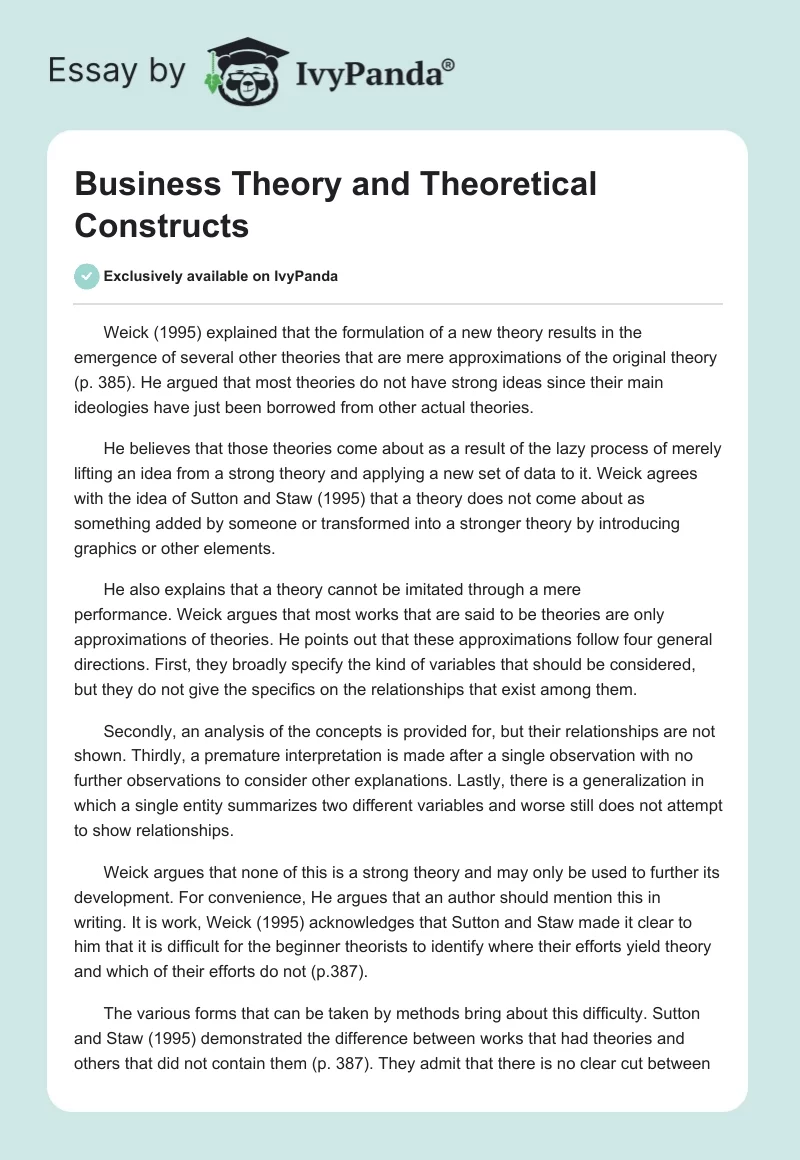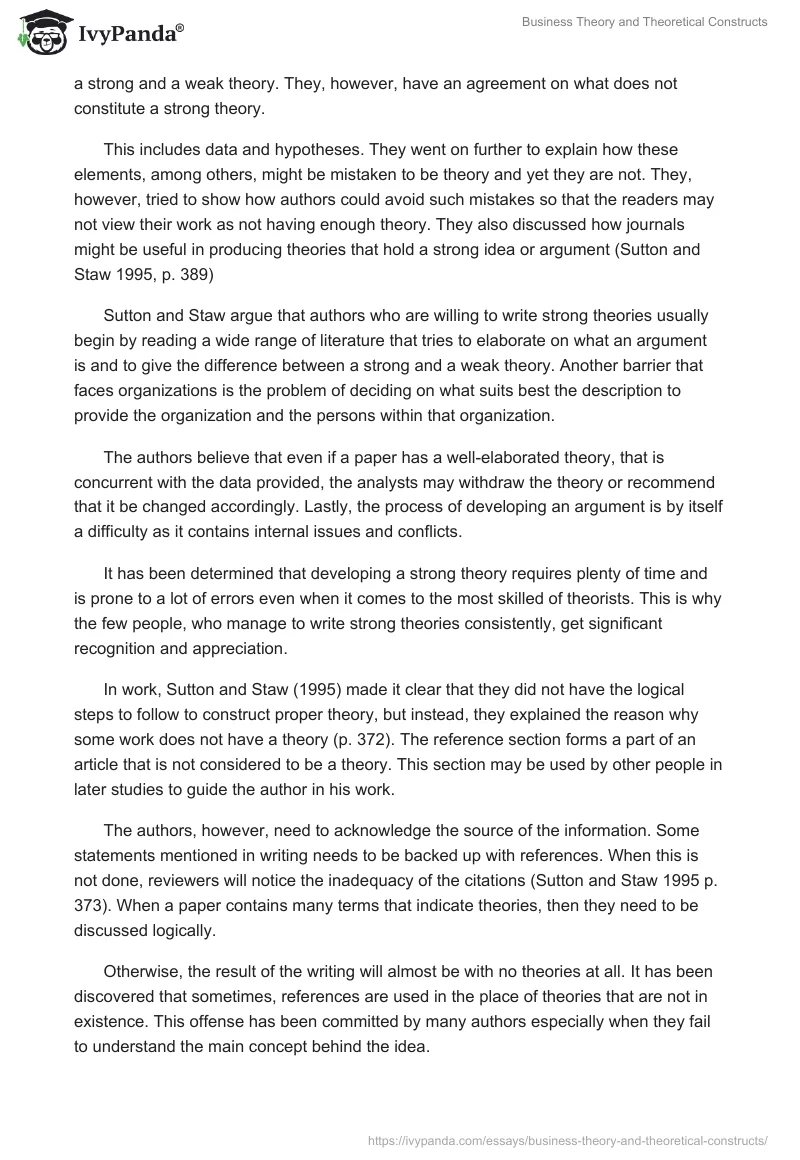Weick (1995) explained that the formulation of a new theory results in the emergence of several other theories that are mere approximations of the original theory (p. 385). He argued that most theories do not have strong ideas since their main ideologies have just been borrowed from other actual theories.
He believes that those theories come about as a result of the lazy process of merely lifting an idea from a strong theory and applying a new set of data to it. Weick agrees with the idea of Sutton and Staw (1995) that a theory does not come about as something added by someone or transformed into a stronger theory by introducing graphics or other elements.
He also explains that a theory cannot be imitated through a mere performance. Weick argues that most works that are said to be theories are only approximations of theories. He points out that these approximations follow four general directions. First, they broadly specify the kind of variables that should be considered, but they do not give the specifics on the relationships that exist among them.
Secondly, an analysis of the concepts is provided for, but their relationships are not shown. Thirdly, a premature interpretation is made after a single observation with no further observations to consider other explanations. Lastly, there is a generalization in which a single entity summarizes two different variables and worse still does not attempt to show relationships.
Weick argues that none of this is a strong theory and may only be used to further its development. For convenience, He argues that an author should mention this in writing. It is work, Weick (1995) acknowledges that Sutton and Staw made it clear to him that it is difficult for the beginner theorists to identify where their efforts yield theory and which of their efforts do not (p.387).
The various forms that can be taken by methods bring about this difficulty. Sutton and Staw (1995) demonstrated the difference between works that had theories and others that did not contain them (p. 387). They admit that there is no clear cut between a strong and a weak theory. They, however, have an agreement on what does not constitute a strong theory.
This includes data and hypotheses. They went on further to explain how these elements, among others, might be mistaken to be theory and yet they are not. They, however, tried to show how authors could avoid such mistakes so that the readers may not view their work as not having enough theory. They also discussed how journals might be useful in producing theories that hold a strong idea or argument (Sutton and Staw 1995, p. 389)
Sutton and Staw argue that authors who are willing to write strong theories usually begin by reading a wide range of literature that tries to elaborate on what an argument is and to give the difference between a strong and a weak theory. Another barrier that faces organizations is the problem of deciding on what suits best the description to provide the organization and the persons within that organization.
The authors believe that even if a paper has a well-elaborated theory, that is concurrent with the data provided, the analysts may withdraw the theory or recommend that it be changed accordingly. Lastly, the process of developing an argument is by itself a difficulty as it contains internal issues and conflicts.
It has been determined that developing a strong theory requires plenty of time and is prone to a lot of errors even when it comes to the most skilled of theorists. This is why the few people, who manage to write strong theories consistently, get significant recognition and appreciation.
In work, Sutton and Staw (1995) made it clear that they did not have the logical steps to follow to construct proper theory, but instead, they explained the reason why some work does not have a theory (p. 372). The reference section forms a part of an article that is not considered to be a theory. This section may be used by other people in later studies to guide the author in his work.
The authors, however, need to acknowledge the source of the information. Some statements mentioned in writing needs to be backed up with references. When this is not done, reviewers will notice the inadequacy of the citations (Sutton and Staw 1995 p. 373). When a paper contains many terms that indicate theories, then they need to be discussed logically.
Otherwise, the result of the writing will almost be with no theories at all. It has been discovered that sometimes, references are used in the place of theories that are not in existence. This offense has been committed by many authors especially when they fail to understand the main concept behind the idea.
At times, this strategy might work in favor of the ignorant or less informed author especially when references are made of some of the famous authors. These well-known books include those that people praise a lot, talk a lot about the book, and yet have not read it.
Writers are required to bring out the ideas that have been used by other scholars to back up their theories and arguments that are being presented by the study at hand. This does not mean that every idea is adopted in the new write-up but rather the main issue is tackled to show that the idea that the author had in mind has been well understood.
It is important to know that the information of other authors should be brought out clearly in the new argument to make sure that one does not need to go through the first write-up to understand. Another section of a write-up that is not part of the theory is the data.
Sutton and Staw acknowledge that data is important in confirming or seconding existing information about the same idea or in the development of new theories all together (Sutton and Staw 1995, p. 373). Data show the type of pattern that exists in work and the theory shows why the patterns appeared in a particular manner and which were observed and which were expected.
There is a big problem when it comes to coming up with an adequate amount of facts to prove the theory. Instead of using proper reasoning, several sequenced findings have been used to prove that the hypothesis is justified. The use of the prior conclusions only cannot give answers to the hypotheses that have been developed, and the results could not be provided from mere reasoning.
Reporting a certain phenomenon as being a repeat of similar scenarios in the past does not necessarily show what the cause of the problem is but rather indicates the likelihood of it happening again in the future. Diagrams within a write-up also do not make up a theory. More sense can, however, be derived from diagrams by displaying them to show relationships in a logical manner.
Other useful diagrams are those that show how processes change over time. Sutton and Staw argue that some writers who are not so good may use several pictures to bring their point home. They, however, argue that a good theory is mainly an interpretation and is verbal; the discussion is clear and can be represented using graphical representation.
Corley and Gioia (2011) argue that there is no universal meaning of the word theory. They attribute this to the difficulty in developing a robust theory (p. 12). According to them, it is a statement of elements and their relationships that indicate the way phenomenon takes place. One of the dimensions that Corley and Gioia believe that it stands out according to AMR is originality.
They believe that editors and reviewers consider these paramount. This is seen in the way they judge the value of the work by what it contributes to the common idea. All papers are supposed to add value and provide insight into the management by showing alternative views on existing ideas or providing an entirely new idea.
According to Corley and Gioia, a good theory is that which is practical since it provides more knowledge in the field of science and it gives direction to research and advances understanding in management. They agree with the idea that the thing that makes a theory stand out from the rest is the fact that it tends towards what is known to be realistic or whereby a group of people is in agreement that a particular theory provides the best understanding and provides a particular direction in which an observed phenomenon takes.
It can be concluded that constructs are not directly visible. He believes that they cannot be viewed as a single observation but are a group of observations. Constructs are simply groups of entities that are widely known to various researchers. They may include minerals, fluids, and animals, just to mention a few.
Constructs are the genesis of theory, and therefore, theory can be described as a group of constructs. In this case, each construct is related to the other. They may be seen as building blocks used to construct the end product that is a theory. He agrees with the works of Sutton and Staw in that construct cannot be used in place of theory since they are not entirely the same thing.
Constructs are just essential entities of making theory. They may be important as entities for a theory but by themselves are inadequate. Construct clarity is important and it follows four conditions. First, construct clarity requires that distinction is made among different concepts.
This requires definitions to be made. Secondly, the author is required to provide the conditions to which a construct will be used or not. Thirdly, the theorists must find a connection with other constructs. Lastly, the theorist must show some form of consistency in the use of the construct during his argument.
Conclusion
Editors are usually quick when it comes to rejecting work that contains constructs that are poorly defined. Where constructs appear not to have a connection, the manuscript is also easily rejected. Theorists are required to be more effective in developing construct and how to use constructs to manage theories and work on improving the construct clarity and its role in guiding research.
References
Corely, G. & Gioia, D. (2011). Building theory about theory building: what constitutes a theoretical contribution? Academic of management Review, 36, p. 12-32.
Sutton, R. & Staw, B. (1995). What Theory Is Not Theorizing Is. Administrative Science Quarterly, 40, p. 371-384.
Weick, E. K. (1995). What Theory Is Not Theorizing Is. Administrative Science Quarterly, 40, p. 385-390.


